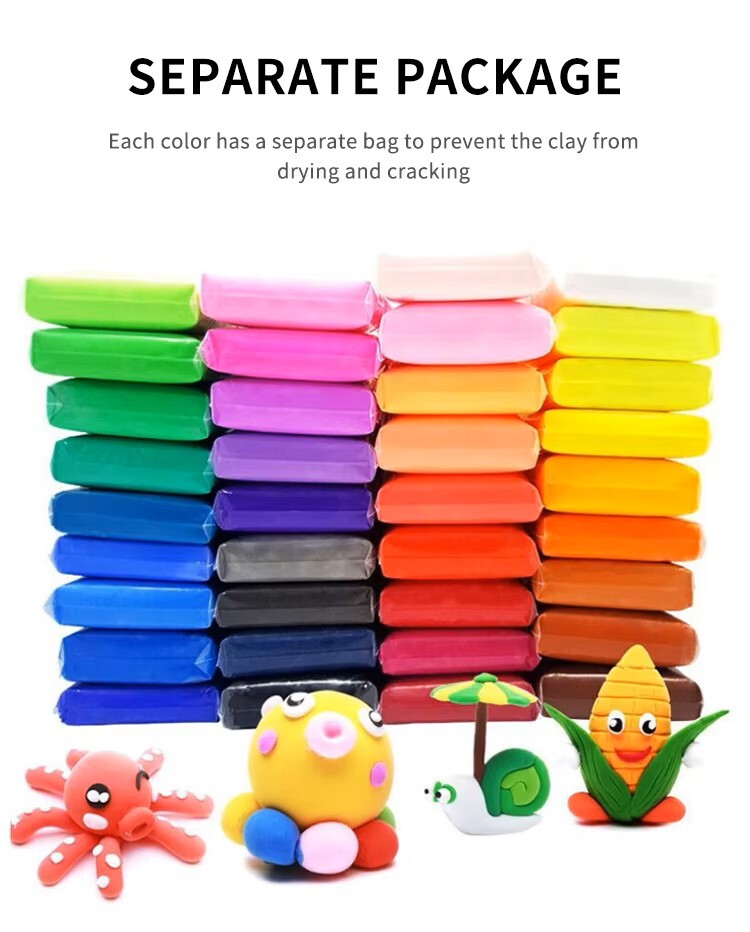- KNOWLEDGE/BLOG -

Children's colored clay is a classic toy to cultivate children's creativity and hands-on ability, but the quality of products on the market varies, and low-quality products may contain heavy metals, borax and other harmful substances that threaten children's health. This article combines third-party testing data and industry standards to provide a one-stop safety guide from ingredients, certification, shopping tips to recommended brands.
一.Core standards for safe coloring clay
1. Ingredients are clearly labeled, and “food-type” materials are preferred.
There are two main types of colored clay materials:
Grain-based colored clay: mainly made of natural ingredients such as flour and rice flour, with food coloring and flavoring, it is environmentally friendly and non-toxic, with a lower risk of accidental ingestion1225.
Non-grain-based colored clay: such as ultra-light clay, crystal clay, etc., usually containing calcium carbonate, glycerin and other chemical materials, need to ensure that they pass the safety test, to avoid the presence of borax, excessive preservatives and other harmful additives1221.
Suggestions for selection:
Check whether the packaging is clearly labeled “grain-based” or the list of ingredients, to avoid three-no products25.
Non-grain-based colored clay should comply with national standards (e.g., GB 6675-2014), and ensure that the amount of boron migration is ≤300mg/kg17.
2. Passing authoritative safety certification
AP Certification: Issued by the American Council on Materials for the Arts and Creativity (ACMI), it represents that the product has passed the toxicity test and is suitable for children's use22.
CE certification: EU safety certification, need to comply with the toy directive EN 71 standards, focusing on the detection of heavy metal content 2225.
GB certification: China GB 6675 standard is the basic threshold, but it is recommended to prioritize the brands that have passed AP/CE certification at the same time, for a more secure safety1217.
3. Sensory and texture testing
Smell: High-quality colored clay should have no pungent chemical smell, while low-quality products may contain formaldehyde or industrial flavorings25.
Touch: the texture is soft and non-sticky, there is no oil residue after kneading, and it is not easy to crack after drying2125.
Color: Avoid fluorescent color or night light color clay, such products may use non-food coloring12.
二.high security color clay brand recommendation
Combining third-party evaluation and market reputation, the following brands have passed strict certification and have outstanding safety:
Play-Doh
Global famous brand, the main flour-based coloring clay, AP certification, biodegradable ingredients, low risk of accidental ingestion412.
Features: soft texture, bright colors, rich supporting molds, suitable for children over 3 years old.
Brighten Ultralight Clay
Domestic high-end brand, focusing on “odorless, colorless, non-sticky hands”, sealed box packaging to prevent drying, CE certification 21.
User feedback: suitable for complex modeling, but the price is high, the cost performance is better than low-cost and inferior products21.
Melody Childhood (JoanMiro)
Spanish brand, through the AP, CE dual certification, color clay containing natural wheat ingredients, supporting tutorials illustrated book to enhance the fun 224.
Advantage: soft colors, delicate texture, suitable for younger children's first experience.
Crayola
The old American brand of painting materials, colored clay tested by the U.S. Toxicology Program, no irritating odor, balanced safety and extensibility 222.
三. Parents' Guide to Avoiding Pitfalls
Be wary of low-priced traps
Colorful clay priced below $10/pack often uses low-quality raw materials, which can easily lead to allergies or dermatitis (e.g., the case of a kindergarten)2125.
Pay attention to age appropriateness
Children under 3 years old are recommended to use grain-based colored clay to avoid the risk of accidental ingestion; non-grain-based products are suitable for children over 4 years old1225.
Preservation and use norms
Sealed storage: Place in a plastic box or original sealed jar after opening to avoid hardening after exposure to air21.
Cleaning after use: Supervise children to wash their hands to prevent residual colored clay from coming into contact with the mouth, nose or furniture25.
四. Industry Trends and Parental Responsibility
According to the 2024 educational toys market data, parents are 60% more concerned about the safety of colored clay, and are more inclined to choose “dual-certified” brands.412 Consumers are advised to actively check the brand's official website or third-party test reports, and to avoid purchasing products based on advertisements alone.
Conclusion: Safety is a prerequisite for creativity
When choosing colorful clay, keep in mind the three-step method of “look at the certification, smell, and check the ingredients”, and give priority to trusting authoritative brands. Click the link below to get the “AP/CE certified coloring clay list” and limited time offers, so that children can release their creativity in a safe environment!
RECOMMENDATION
MAIN PRODUCTS
The company currently has 68 production lines, and its main products are super light clay, pearl mud, crystal mud, ramen mud, beach sand and other series of specifications, with an annual production capacity of more than 5,000 tons.
CONTACT US
